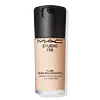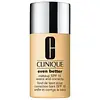Mac Cosmetics Studio Fix Fluid SPF 15 24HR Matte Foundation + Oil Control Versus Clinique Even Better Makeup Broad Spectrum SPF 15
What's inside
What's inside
 Key Ingredients
Key Ingredients

 Benefits
Benefits

 Concerns
Concerns

 Ingredients Side-by-side
Ingredients Side-by-side

Water
Skin ConditioningMethyl Trimethicone
Skin ConditioningDimethicone
EmollientTrimethylsiloxysilicate
EmollientPEG-10 Dimethicone
Skin ConditioningButylene Glycol
HumectantIsododecane
EmollientPolyethylene
AbrasiveCetyl PEG/PPG-10/1 Dimethicone
EmulsifyingMagnesium Sulfate
Algae Extract
EmollientLaminaria Saccharina Extract
Skin ProtectingSodium Hyaluronate
HumectantSalix Nigra Bark Extract
Skin ProtectingTocopheryl Acetate
AntioxidantCaffeine
Skin ConditioningLecithin
EmollientHydrogenated Lecithin
EmulsifyingDisteardimonium Hectorite
StabilisingSilica
AbrasiveXanthan Gum
EmulsifyingDimethicone Crosspolymer
Emulsion StabilisingTriethoxycaprylylsilane
Dimethicone/PEG-10/15 Crosspolymer
Methoxy Amodimethicone/Silsesquioxane Copolymer
Skin ConditioningSorbitan Sesquioleate
EmulsifyingSalicylic Acid
MaskingSodium Citrate
BufferingLaureth-7
EmulsifyingMethyldihydrojasmonate
MaskingPropylene Carbonate
SolventAlumina
AbrasiveDipropylene Glycol
HumectantPentaerythrityl Tetra-Di-T-Butyl Hydroxyhydrocinnamate
AntioxidantBHT
AntioxidantPhenoxyethanol
PreservativeSorbic Acid
PreservativeChloroxylenol
AntimicrobialCI 77891
Cosmetic ColorantCI 77491
Cosmetic ColorantCI 77492
Cosmetic ColorantCI 77499
Cosmetic ColorantWater, Methyl Trimethicone, Dimethicone, Trimethylsiloxysilicate, PEG-10 Dimethicone, Butylene Glycol, Isododecane, Polyethylene, Cetyl PEG/PPG-10/1 Dimethicone, Magnesium Sulfate, Algae Extract, Laminaria Saccharina Extract, Sodium Hyaluronate, Salix Nigra Bark Extract, Tocopheryl Acetate, Caffeine, Lecithin, Hydrogenated Lecithin, Disteardimonium Hectorite, Silica, Xanthan Gum, Dimethicone Crosspolymer, Triethoxycaprylylsilane, Dimethicone/PEG-10/15 Crosspolymer, Methoxy Amodimethicone/Silsesquioxane Copolymer, Sorbitan Sesquioleate, Salicylic Acid, Sodium Citrate, Laureth-7, Methyldihydrojasmonate, Propylene Carbonate, Alumina, Dipropylene Glycol, Pentaerythrityl Tetra-Di-T-Butyl Hydroxyhydrocinnamate, BHT, Phenoxyethanol, Sorbic Acid, Chloroxylenol, CI 77891, CI 77491, CI 77492, CI 77499
Ethylhexyl Methoxycinnamate 5.9%
UV AbsorberTitanium Dioxide 3.5%
Cosmetic ColorantZinc Oxide 2.8%
Cosmetic ColorantWater
Skin ConditioningMethyl Trimethicone
Skin ConditioningPhenyl Trimethicone
Skin ConditioningDimethicone
EmollientTriethylhexanoin
MaskingButylene Glycol
HumectantTrimethylsiloxysilicate
EmollientYeast Extract
Skin ConditioningPEG-10 Dimethicone
Skin ConditioningLauryl PEG-9 Polydimethylsiloxyethyl Dimethicone
Skin ConditioningAlumina
AbrasiveCitrus Grandis Peel Extract
AstringentBetula Alba Bark Extract
MaskingSaccharomyces Lysate Extract
HumectantAstrocaryum Murumuru Seed Butter
EmollientC12-15 Alkyl Benzoate
AntimicrobialGlycerin
HumectantSodium Myristoyl Sarcosinate
CleansingAcetyl Glucosamine
Skin ConditioningCaprylyl Methicone
Skin ConditioningMethicone
EmollientPolyglyceryl-6 Polyricinoleate
EmulsifyingDisteardimonium Hectorite
StabilisingDimethicone Crosspolymer-3
Skin ConditioningIsopropyl Titanium Triisostearate
EmollientLecithin
EmollientLaureth-7
EmulsifyingTocopheryl Acetate
AntioxidantMagnesium Ascorbyl Phosphate
AntioxidantDimethicone/PEG-10/15 Crosspolymer
Dipropylene Glycol
HumectantSodium Chloride
MaskingCaprylyl Glycol
EmollientTetrahexyldecyl Ascorbate
AntioxidantDisodium EDTA
Phenoxyethanol
PreservativePolyaminopropyl Biguanide
PreservativeCI 77891
Cosmetic ColorantIron Oxides
Mica
Cosmetic ColorantCI 77163
Cosmetic ColorantEthylhexyl Methoxycinnamate 5.9%, Titanium Dioxide 3.5%, Zinc Oxide 2.8%, Water, Methyl Trimethicone, Phenyl Trimethicone, Dimethicone, Triethylhexanoin, Butylene Glycol, Trimethylsiloxysilicate, Yeast Extract, PEG-10 Dimethicone, Lauryl PEG-9 Polydimethylsiloxyethyl Dimethicone, Alumina, Citrus Grandis Peel Extract, Betula Alba Bark Extract, Saccharomyces Lysate Extract, Astrocaryum Murumuru Seed Butter, C12-15 Alkyl Benzoate, Glycerin, Sodium Myristoyl Sarcosinate, Acetyl Glucosamine, Caprylyl Methicone, Methicone, Polyglyceryl-6 Polyricinoleate, Disteardimonium Hectorite, Dimethicone Crosspolymer-3, Isopropyl Titanium Triisostearate, Lecithin, Laureth-7, Tocopheryl Acetate, Magnesium Ascorbyl Phosphate, Dimethicone/PEG-10/15 Crosspolymer, Dipropylene Glycol, Sodium Chloride, Caprylyl Glycol, Tetrahexyldecyl Ascorbate, Disodium EDTA, Phenoxyethanol, Polyaminopropyl Biguanide, CI 77891, Iron Oxides, Mica, CI 77163
Ingredients Explained
These ingredients are found in both products.
Ingredients higher up in an ingredient list are typically present in a larger amount.
Alumina is another name for the compound aluminum oxide. It is used as a thickener, absorbent, and abrasive.
As an absorbent, alumina can give a mattifying effect. It is used in mineral sunscreens to help coat nano-sized filters, such as titanium dioxide. By increasing the size of the UV filters, these ingredients stay on the skin for a longer time. By coating small sized ingredients, alumina helps thicken a product.
Alumina may be used as an abrasive, or exfoliant.
Alumina is naturally occurring in the mineral corundum. Certain varieties of corundum create rubies and sapphires. Corundum is also the crystalline form of alumina.
Learn more about AluminaButylene Glycol (or BG) is used within cosmetic products for a few different reasons:
Overall, Butylene Glycol is a safe and well-rounded ingredient that works well with other ingredients.
Though this ingredient works well with most skin types, some people with sensitive skin may experience a reaction such as allergic rashes, closed comedones, or itchiness.
Learn more about Butylene GlycolCi 77891 is a white pigment from Titanium dioxide. It is naturally found in minerals such as rutile and ilmenite.
It's main function is to add a white color to cosmetics. It can also be mixed with other colors to create different shades.
Ci 77891 is commonly found in sunscreens due to its ability to block UV rays.
Learn more about CI 77891Dimethicone is a type of synthetic silicone created from natural materials such as quartz.
What it does:
Dimethicone comes in different viscosities:
Depending on the viscosity, dimethicone has different properties.
Ingredients lists don't always show which type is used, so we recommend reaching out to the brand if you have questions about the viscosity.
This ingredient is unlikely to cause irritation because it does not get absorbed into skin. However, people with silicone allergies should be careful about using this ingredient.
Note: Dimethicone may contribute to pilling. This is because it is not oil or water soluble, so pilling may occur when layered with products. When mixed with heavy oils in a formula, the outcome is also quite greasy.
Learn more about DimethiconeDimethicone/PEG-10/15 Crosspolymer is a type of silicone.
Dipropylene Glycol is a synthetically created humectant, stabilizer, and solvent.
This ingredient helps:
Dipropylene glycol is technically an alcohol, but it belongs to the glycol family (often considered part of the ‘good’ alcohols). This means it is hydrating and gentle on skin unlike drying solvent alcohols like denatured alcohol.
As a masking agent, Dipropylene Glycol can be used to cover the smell of other ingredients. However, it does not have a scent.
Studies show Dipropylene Glycol is considered safe to use in skincare.
Learn more about Dipropylene GlycolDisteardimonium Hectorite comes from the clay mineral named hectorite. It is used to add thickness to a product.
It can also help stabilize a product by helping to disperse other ingredients.
Hectorite is a rare, white clay mineral.
Learn more about Disteardimonium HectoriteLaureth-7 is created by the ethoxylation of lauryl alcohol using ethylene oxide. Lauryl alcohol is a fatty alcohol with hydrating properties.
This ingredient is an emulsifier and cleansing ingredient. As an emulsifier, it is used to prevent ingredients from separating. It also helps cleanse the skin by gathering dirt, oil, and pollutants to be rinsed away.
Lecithin is a term for a group of substances found in the cell membranes of plants, animals, and humans. They are made up of mixture of phospholipids.
This ingredient has emollient and emulsifying properties.
As an emollient, lecithen helps soften the skin and creates a barrier to keep moisture in.
As an emulsifier, it also helps prevent water and oil ingredients from separating. Lecithin can also help ingredients be better absorbed by the skin.
This is because the phospholipids in lecithin produce liposomes. Liposomes help other ingredients get through the skin barrier.
Depending on the source of this ingredient, lecithin may not be fungal acne safe. This is because some sources of lecithin come from soybean oil, which may feed the malassezia yeast that feeds fungal acne.
We recommend reaching out to the brand you are purchasing from to inquire about the source of their lecithin.
Some other names for this ingredient include soy lecithin and deoiled soy lecithin.
Learn more about LecithinMethyl Trimethicone is a type of silicone. It is a solvent and emulsifier.
Solvents are used to keep ingredients together in a product. They can help dissolve ingredients to stable bases or help evenly distribute ingredients throughout the product.
Emulsifiers help stabilize a product. It does this by preventing certain ingredients from separating.
Methyl Trimethicone does not get absorbed into the skin.
Learn more about Methyl TrimethiconePeg-10 Dimethicone is silicone with conditioner and emulsifier properties. It mostly acts as an emollient in skincare and and humectant in haircare.
According to the manufacturer, acidic formulations decrease the stability of this ingredient. It works best in neutral or near neutral formulations.
Phenoxyethanol is a preservative that has germicide, antimicrobial, and aromatic properties. Studies show that phenoxyethanol can prevent microbial growth. By itself, it has a scent that is similar to that of a rose.
It's often used in formulations along with Caprylyl Glycol to preserve the shelf life of products.
Tocopheryl Acetate is AKA Vitamin E. It is an antioxidant and protects your skin from free radicals. Free radicals damage the skin by breaking down collagen.
One study found using Tocopheryl Acetate with Vitamin C decreased the number of sunburned cells.
Tocopheryl Acetate is commonly found in both skincare and dietary supplements.
Learn more about Tocopheryl AcetateThis silicone is an emollient. Emollients create a thin film on the skin to prevent moisture from escaping.
It is not soluble in water and helps increase water-resistance in products.
According to a manufacturer, it can blend seamlessly with silicone oils, such as Cyclopentasiloxane.
Learn more about TrimethylsiloxysilicateWater. It's the most common cosmetic ingredient of all. You'll usually see it at the top of ingredient lists, meaning that it makes up the largest part of the product.
So why is it so popular? Water most often acts as a solvent - this means that it helps dissolve other ingredients into the formulation.
You'll also recognize water as that liquid we all need to stay alive. If you see this, drink a glass of water. Stay hydrated!
Learn more about Water